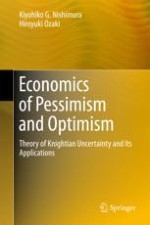2017 | OriginalPaper | Buchkapitel
14. Learning Under Knightian Uncertainty
verfasst von : Kiyohiko G. Nishimura, Hiroyuki Ozaki
Erschienen in: Economics of Pessimism and Optimism
Verlag: Springer Japan
Aktivieren Sie unsere intelligente Suche, um passende Fachinhalte oder Patente zu finden.
Wählen Sie Textabschnitte aus um mit Künstlicher Intelligenz passenden Patente zu finden. powered by
Markieren Sie Textabschnitte, um KI-gestützt weitere passende Inhalte zu finden. powered by
